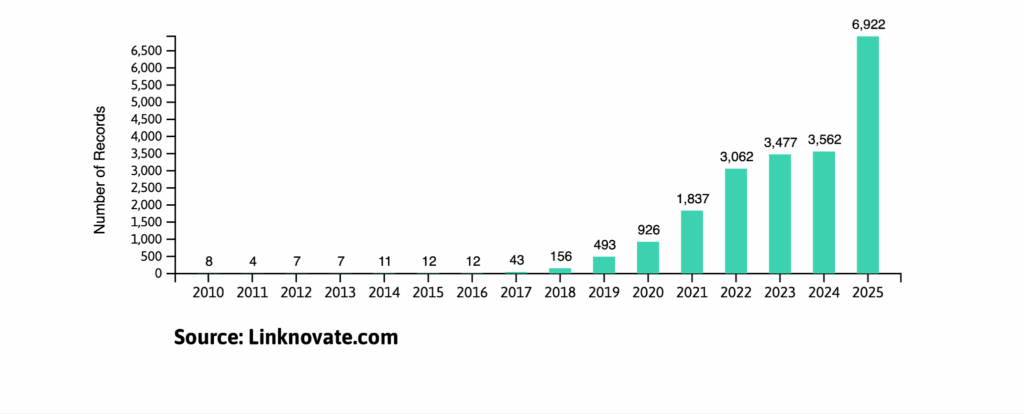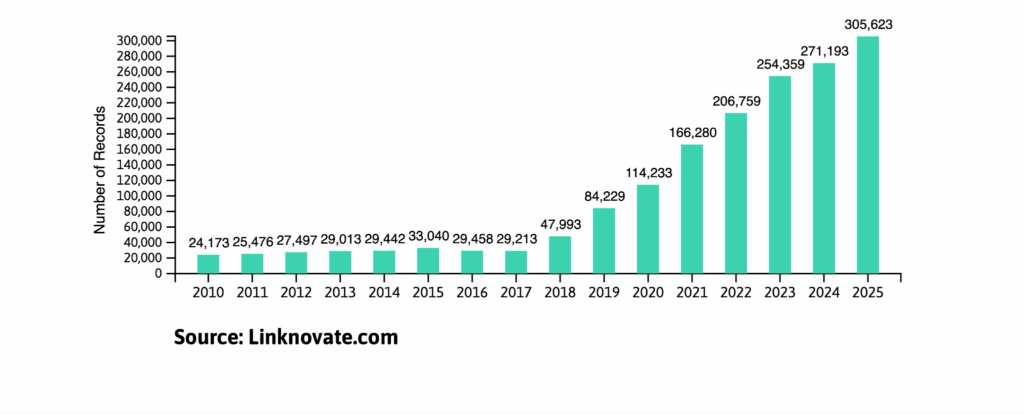Healthcare is entering one of the most transformative periods in its history. At Linknovate, we conducted a comprehensive analysis of emerging healthcare trends, identifying the technologies gaining momentum, the companies leading innovation, and the breakthroughs reshaping the future of health-tech.
Our research reveals clear signals of where the industry is heading, and which innovations will matter most in 2026 and beyond.
👉 Download the full Innovation Report: Trends in Healthcare to explore all insights, data, and top innovators driving the next wave of healthcare transformation.
Innovation Trends in Healthcare
IoT-Powered Smart Hospitals
IoT (Internet of Things) technologies are rapidly becoming the backbone of modern healthcare systems. According to Linknovate data, global research output on IoT in healthcare surged in 2025.
IoT innovation areas gaining traction include:
- Wearable diagnostics: self-powered sensors, e-tattoos, and biosignal monitoring systems.
- Smart wards: real-time patient tracking, oxygen-level alerts, environmental monitoring.
- Low-cost sensing & 3D-printed devices: enabling scalable deployment in hospitals.
- IoT-enabled clinical trials and precision monitoring for chronic diseases.
These technologies are shifting hospitals from reactive to predictive and preventive systems, improving efficiency and patient outcomes.
Digital Twins Driving Precision Healthcare
Digital twins are virtual replicas of patients, organs, or clinical systems. This technology is experiencing a breakthrough moment. Global publication volume has grown sharply, with key contributions from institutions such as:
- Barcelona Supercomputing Center (Spain)
- Institute for Bioengineering of Catalonia (IBEC) (Spain)
- National University of Singapore (NUS)
- MIT (US)
Top digital twins application areas include:
- Cardiology: digital twins for cardiovascular risk prediction and personalized therapy planning.
- Neurology: stroke management models for ischemic and hemorrhagic events.
- Surgery: real-time simulations to guide complex procedures.
- Hospital operations: predictive optimization of workflows and resources.
In 2026, digital twins are expected to evolve from research prototypes into clinical decision-support tools, accelerating the path to precision medicine.
Sustainability & Green Hospital Innovation
Sustainability is rapidly becoming a strategic priority for healthcare systems worldwide. Linknovate’s data shows a sharp increase in publications and projects related to green hospitals, with SMEs leading innovation.
Emerging sustainability drivers in healthcare include:
- Energy-efficient hospital design with smart building systems.
- Sustainable clinical practices, including low-impact inhalers and greener dermatology procedures.
- Circular healthcare initiatives, such as device reuse and waste reduction programs.
- Green HRM and leadership models embedded into healthcare operations.
This shift is essential as hospitals account for significant carbon emissions, making sustainability a foundational pillar of healthcare modernization.
Self-Powered Wearables & Next-Gen Biosensing
Across IoT and digital health publications, a clear trend emerges: self-powered health wearables using nanogenerators, thermoelectric systems, and biomechanical energy harvesting.
Innovation highlights from the report include:
- Triboelectric nanogenerators (TENGs) enabling self-powered sensors.
- Thermoelectric e-tattoo systems for continuous temperature mapping.
- Smart clothing for arrhythmia prediction using digital twins.
- Integrated air-quality and environmental health sensors and quantum IoT for hospitals.
These technologies remove traditional power constraints, enabling continuous monitoring with zero maintenance, critical for next-gen home care and smart hospital systems.
AI-Enhanced Healthcare Systems
While not the main focus of the report, Linknovate’s dataset shows strong cross-trend activity where AI intersects with IoT, digital twins, and sustainability.
Key emerging AI applications include:
- AI-assisted digital twin modeling for real-time simulation.
- Predictive maintenance for hospital infrastructure.
- AI-driven energy optimization in hospital buildings.
- Natural language processing (NLP) to improve documentation and administrative efficiency.
As these technologies converge, hospitals move toward self-optimizing infrastructures and increasingly automated clinical workflows.
Innovation Intelligence in Healthcare
Linknovate data shows strong global momentum in three innovation pillars transforming healthcare:
- IoT is powering the next generation of smart, connected hospitals.
- Digital twins are unlocking data-driven precision care.
- Sustainability is shifting from aspiration to strategic priority across health systems.
To explore all datasets, key organizations, and emerging technologies, download the full Innovation Report: Trends in Healthcare.








